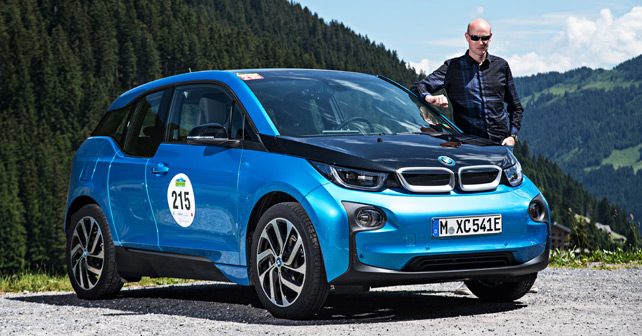
Jens brings you up to date with the latest, and most interesting, happenings from the global automotive industry.
Driving an electric isn’t what it used to be, as I found out as BMW’s guest at the Silvretta Rallye for electric vehicles. It’s run on the sidelines of the renowned Silvretta Classic Rallye, which covers hundreds of kilometres in the Austrian Alps. From pre-war cars to rare exotics, and the usual array of Porsche 911s and Mercedes SL models, the Classic Silvretta is one of the most beautiful and somewhat challenging events of its kind.
The E-Silvretta is a much shorter version of the rally, and the seventh edition took place this year. Day 1 covered a mere 84 kilometres, while day 2 saw 140 kilometres split in half by an extensive lunch break. Those distances were a challenge for early electrics several years ago. Not so for the BMW i3 with the larger 94-Ah battery pack that I drove on day 2. During lunch, we simply parked the car on the road and didn’t bother with charging the batteries – and we still had more than half of the battery capacity left when we made it to our destination. Moreover, there was not the slightest need to conserve energy by turning off the AC or showing any restraint with the right foot. The i3 has morphed into a true long-distance electric.
What a contrast to the early models. When I took an i3 with the Kymco-supplied range extender to the Vienna Engine symposium two years ago, a 600 kilometre drive, then-BMW chief engineer Herbert Diess – now at VW – was not amused. “That’s no what this car was made for,” he said.
The 740 Le xDrive, of course, was even more convenient at the E-Silvretta – but the battery-only range of this plug-in hybrid shrunk dramatically after the first ascent. We managed 15 miles instead of the promised 30, but then the gasoline-powered four-cylinder engine kicked in, with the E-motor providing the occasional boost. It’s a great luxury sedan, but its appetite for fuel is not smaller than that of a non-hybrid conventionally powered turbo-diesel.
The rally was great, but next time I’d like more of a challenge. The distance could be adjusted to max out a fully electric’s capabilities. And, in plug-in hybrids, the time driven with the assistance of the internal combustion engine should be converted into some kind of a penalty.
The future, presented in Northern Italy
The crossover SUV juggernaut is unstoppable, and I’ve had the pleasure of driving the latest example in the mountains to the northwest of Torino – the Mercedes-Benz GLC Coupe. In my eyes, it’s the best crossover SUV four-door coupe to date. It looks more sensual and expensive than the boxy BMW X4, and is technologically vastly superior to the Range Rover Evoque with its Ford-based platform.
Down the road, the GLC Coupe will be offered as the Mercedes-AMG GLC 63 Coupe, with a twin-turbocharged 4.0-litre V8 that produces at least 469 horsepower. That car will put its competitors from Audi, BMW and Porsche to absolute shame. If there’s one problem with the GLC Coupe, it’s in the form of the base GLC. That crossover SUV is so beautifully styled that the Coupe version doesn’t do much to improve its looks. The rear end, in fact, looks a bit awkward. Its taillights are taken straight from the GLE Coupe, and they look a bit oversized on the smaller model. On the plus side, the GLC Coupe’s steering is even sharper than the regular GLC.
A few days later, I was near Milan to drive the face-lifted Volkswagen Up. It’s taken the company four years to turbocharge the 1.0-litre three-banger under its short hood. But it was worth it! With 90 horsepower and 160Nm of torque instead of the naturally aspirated model’s 95Nm, the Up becomes a much more capable performer. It is really quick around town, and it doesn’t let up until it reaches 185km/h. Next year, VW will squeeze even more power out of this engine. I hear the Up GTI will produce 115 horsepower.
Unfortunately, the new engine comes in conjunction with a facelift that has taken away the visual purism of the original model. The Up still has a unique shape, but details like the front and rear bumper, including a sorry simulation of a diffuser, are far more conventional than before. The same, to a degree, is true of the interior – with one exception. The colour and trim choices for the seats are exceptionally daring and futuristic.
Tesla’s Autopilot
The first death in an autonomously driving car happened in a Tesla, and unfortunately this is not a surprise to the automotive community at all. Over the past year, executives from suppliers and other carmakers have voiced grave concerns over Tesla’s aggressive strategy in rolling out their pretentiously named “Autopilot.” Tesla’s system – and I have written this before – is inferior to some of the competition, yet it was possible to operate it without the permanent feedback required by everyone else’s cars. The consensus went something like this: “They could ruin autonomous driving for all.”
After doing virtually nothing post-accident for two months, including keeping customers out in the field blissfully unaware of the fatal event, Tesla hastened to point out that it was the first fatality in around 210 million kilometres driven with autopilot – contrasting it with the global average of around one fatality in 95 million kilometres driven. This interesting comparison, of course, includes not just brand-new, luxury-class sedans like the Tesla Model S, but every beater car driven anywhere in the world. Like its Autopilot, the entire company has a steep learning curve ahead.




















Write your Comment